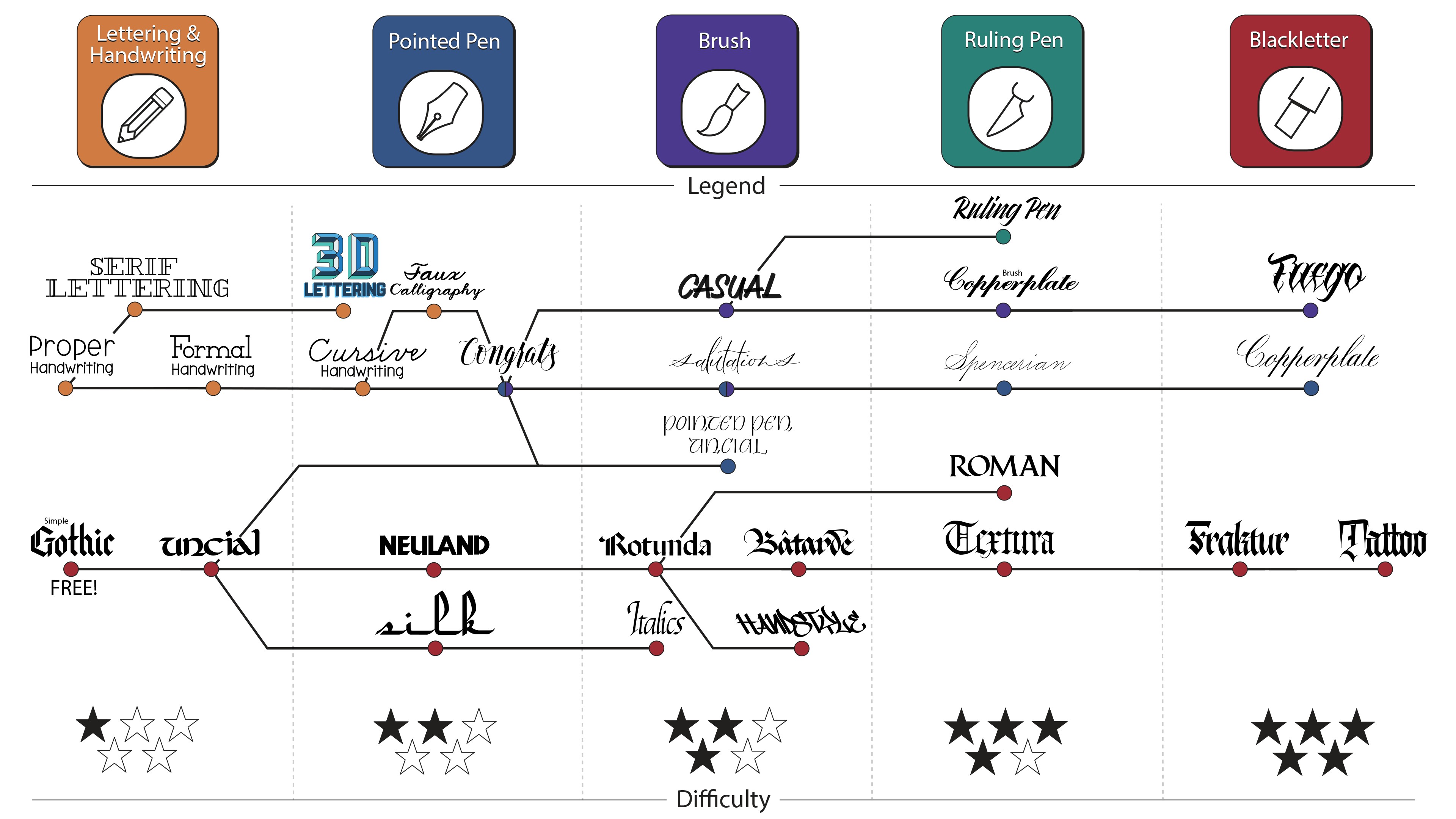Learning calligraphy for beginners can be a rewarding journey, transforming simple handwriting into beautiful art. At LEARNS.EDU.VN, we provide a structured approach to master this skill, offering everything from selecting the right tools to mastering different calligraphy styles. Dive in and discover how to create stunning lettering that will impress everyone.
1. Understanding Calligraphy: A Beginner’s Perspective
What is calligraphy, and why should you consider learning it? Calligraphy, often defined as the art of beautiful writing, goes beyond mere penmanship. It’s a form of visual art that combines skill, creativity, and a deep understanding of letterforms. Learning calligraphy can open doors to personalized art, unique gift creation, and even career opportunities. You’ll develop an appreciation for typography and design, all while enhancing your fine motor skills and hand-eye coordination.
1.1. The Allure of Calligraphy
Calligraphy isn’t just about writing prettily; it’s about expressing yourself through letterforms. The rhythmic strokes and elegant curves have a meditative quality, making it a relaxing and fulfilling hobby. In a digital age, the tactile nature of calligraphy provides a welcome escape, allowing you to create something tangible and personal.
1.2. Calligraphy vs. Hand Lettering: What’s the Difference?
Many beginners often confuse calligraphy with hand lettering, but they are distinct art forms. Calligraphy involves writing letters in a single stroke, adhering to specific rules and techniques. Hand lettering, on the other hand, is more illustrative. It allows you to draw letters, giving you greater freedom in terms of style and composition. Think of calligraphy as handwriting with flair, while hand lettering is drawing with letters.
1.3. Benefits of Learning Calligraphy
Learning calligraphy offers numerous benefits beyond creating beautiful art:
- Enhanced Creativity: Calligraphy encourages you to explore different styles and techniques, boosting your creative thinking.
- Improved Focus: The precision required in calligraphy enhances concentration and attention to detail.
- Relaxation and Mindfulness: The repetitive strokes can be meditative, reducing stress and promoting relaxation.
- Personalized Art: Create unique cards, invitations, and artwork that reflect your personal style.
- Career Opportunities: Calligraphy skills are valuable in graphic design, wedding stationery, and custom artwork.
2. Identifying Your Calligraphy Style
What style of calligraphy resonates with you? Before diving into tools and techniques, it’s essential to explore the different calligraphy styles. Each style has its unique characteristics, from traditional scripts to modern interpretations. Understanding these styles will help you choose the one that aligns with your aesthetic preferences and goals.
2.1. Exploring Different Calligraphy Styles
Calligraphy encompasses a wide range of styles, each with its own historical context and distinct characteristics. Here are some popular styles to consider:
- Blackletter: Also known as Gothic or Old English, blackletter is characterized by its bold, dramatic strokes and dense letterforms. It’s often used in formal documents and traditional settings.
- Copperplate: This elegant script is known for its flowing lines and delicate contrast between thick and thin strokes. Copperplate is often used in wedding invitations and formal correspondence.
- Spencerian: Similar to Copperplate, Spencerian is a graceful script that emphasizes fluidity and rhythm. It was widely used in business correspondence in the 19th century.
- Italic: A slanted, flowing script that offers a balance between formality and readability. Italic is a versatile style suitable for various applications.
- Modern Calligraphy: This contemporary style breaks away from traditional rules, allowing for greater creativity and experimentation. Modern calligraphy often incorporates elements from different scripts.
- Brush Calligraphy: Achieved using brush pens, this style offers a painterly quality with varying stroke widths. It’s popular for creating expressive and dynamic lettering.
Alt text: Calligraphy roadmap showing different styles and difficulty levels for beginners.
2.2. The Calligraphy Roadmap: Finding Your Path
Choosing a calligraphy style can be overwhelming, especially for beginners. The Calligraphy Roadmap is a visual guide that simplifies the process, categorizing styles by difficulty and tool requirements. This roadmap helps you identify a starting point and gradually progress to more challenging scripts.
2.3. Matching Styles to Tools
Different calligraphy styles require different tools. Blackletter is typically written with broad-edged pens, while Copperplate and Spencerian require pointed pens. Modern calligraphy can be achieved with various tools, including brush pens and markers. Understanding the relationship between style and tools is crucial for success.
3. Essential Calligraphy Tools for Beginners
What tools do you need to begin your calligraphy journey? The right tools can make a significant difference in your learning experience. While advanced calligraphers may have extensive collections, beginners can start with a few essential items. Quality tools will not only make the process easier but also inspire you to continue practicing.
3.1. Basic Calligraphy Supplies
Here’s a list of essential tools for beginner calligraphers:
- Pens:
- Broad-edged pens: Ideal for Blackletter and foundational scripts. Look for sets with varying nib sizes to create different stroke widths.
- Pointed pens: Essential for Copperplate and Spencerian styles. You’ll need a pen holder and a selection of nibs.
- Brush pens: Versatile for modern calligraphy and brush lettering. Experiment with different sizes and brands to find your preference.
- Inks:
- India ink: A reliable choice for most calligraphy styles. It’s waterproof and produces crisp, dark lines.
- Calligraphy inks: Available in a wide range of colors and finishes. Look for inks specifically designed for calligraphy to ensure smooth flow and consistent results.
- Paper:
- Calligraphy paper: Smooth, non-absorbent paper that prevents ink from bleeding.
- Practice paper: Less expensive paper for practicing letterforms and exercises.
- Other Tools:
- Ruler: For drawing guidelines and measuring spacing.
- Pencil: For sketching and planning layouts.
- Eraser: For correcting mistakes.
- Inkwell or dinky dip: To hold your ink when using a pointed pen.
- Cleaning supplies: For cleaning your pens and nibs.
3.2. Choosing the Right Pens for Your Style
Selecting the right pen is crucial for achieving the desired effect in your chosen calligraphy style. Broad-edged pens create consistent stroke widths, while pointed pens allow for varying line thickness through pressure. Brush pens offer a more flexible and painterly approach.
| Pen Type | Style Suitability | Key Features |
|---|---|---|
| Broad-edged pens | Blackletter, Foundational, Gothic | Consistent stroke widths, formal appearance |
| Pointed pens | Copperplate, Spencerian, Engrosser’s Script | Varying line thickness, elegant and flowing lines |
| Brush pens | Modern Calligraphy, Brush Lettering | Flexible, painterly strokes, versatile for different styles |
| Fineliner pens | Faux calligraphy, beginner practice | Allows to mimic calligraphy style while training |



3.3. Ink and Paper Considerations
The type of ink and paper you use can significantly impact the quality of your calligraphy. India ink is a reliable choice for its waterproof properties and rich color. Calligraphy paper should be smooth and non-absorbent to prevent ink from feathering or bleeding.
4. Mastering Basic Calligraphy Techniques
What are the fundamental techniques to master calligraphy? Like any art form, calligraphy requires practice and a solid understanding of basic techniques. Mastering these techniques will provide a strong foundation for developing your skills and exploring more advanced styles.
4.1. Posture and Pen Hold
Proper posture and pen hold are essential for comfortable and controlled writing. Sit upright with your feet flat on the floor and your paper positioned at a slight angle. Hold the pen loosely, allowing your hand and arm to move freely. Avoid gripping the pen too tightly, as this can cause fatigue and reduce control.
4.2. Understanding Basic Strokes
Calligraphy is built upon a series of basic strokes, each contributing to the overall form of the letters. These strokes include:
- Upstrokes: Thin lines created by moving the pen upwards with minimal pressure.
- Downstrokes: Thick lines created by moving the pen downwards with increased pressure.
- Hairlines: Very thin lines created with minimal pressure, often used for connecting strokes.
- Serifs: Small decorative strokes at the end of a main stroke.
- Ascenders: The part of a letter that extends above the x-height (e.g., the top of “b” or “h”).
- Descenders: The part of a letter that extends below the baseline (e.g., the bottom of “g” or “p”).
4.3. Practicing Letterforms
Once you understand the basic strokes, it’s time to start practicing letterforms. Begin with simple letters and gradually progress to more complex ones. Pay attention to the proportions, spacing, and consistency of your letters. Use practice sheets with guidelines to help you maintain uniformity.
4.4. Consistent Practice
Consistency is key to improving your calligraphy skills. Set aside dedicated practice time each day, even if it’s just for 15-20 minutes. Regular practice will help you develop muscle memory and refine your technique.
5. Structured Practice Sheets: Your Learning Companion
How can structured practice sheets accelerate your learning? Structured practice sheets are invaluable tools for beginner calligraphers. These sheets provide guided exercises, letter templates, and spacing guidelines to help you develop consistency and accuracy. LEARNS.EDU.VN offers a variety of practice sheets tailored to different calligraphy styles.
5.1. Benefits of Using Practice Sheets
Practice sheets offer several benefits for beginner calligraphers:
- Guided Learning: Provides step-by-step instructions and letter templates.
- Consistency: Helps maintain uniform letter heights, widths, and spacing.
- Accuracy: Promotes accurate stroke formation and letter proportions.
- Progress Tracking: Allows you to monitor your progress and identify areas for improvement.
- Confidence Building: Provides a structured approach that builds confidence as you master each exercise.
5.2. Types of Practice Sheets
There are various types of practice sheets available, each focusing on different aspects of calligraphy:
- Basic Stroke Exercises: Focuses on mastering upstrokes, downstrokes, hairlines, and other fundamental strokes.
- Letterform Drills: Provides letter templates with guidelines for practicing individual letters.
- Word and Sentence Practice: Offers exercises for writing words and sentences, focusing on spacing and rhythm.
- Style-Specific Sheets: Tailored to specific calligraphy styles, such as Blackletter, Copperplate, or Modern Calligraphy.
5.3. Creating Your Own Practice Sheets
While pre-made practice sheets are helpful, you can also create your own to focus on specific areas or styles. Use a ruler and pencil to draw guidelines on paper, creating templates for letters, words, or exercises.
6. Staying Motivated and Inspired
How do you maintain motivation and inspiration in your calligraphy journey? Learning calligraphy can be challenging, and it’s easy to lose motivation along the way. Staying inspired is crucial for continued progress and enjoyment.
6.1. Setting Realistic Goals
Set achievable goals to keep yourself motivated. Start with small, manageable tasks, such as mastering a few letters each week. As you progress, gradually increase the difficulty of your goals.
6.2. Finding Inspiration
Surround yourself with inspiring calligraphy examples. Explore calligraphy books, websites, and social media accounts. Attend calligraphy workshops or join online communities to connect with other calligraphers.
6.3. Overcoming Challenges
Expect to encounter challenges along the way. Don’t get discouraged by mistakes or setbacks. View them as learning opportunities and keep practicing. Seek feedback from experienced calligraphers to identify areas for improvement.
Alt text: Calligraphy combined with a landscape photograph, inspiring creativity.
6.4. Joining a Calligraphy Community
Connecting with other calligraphers can provide support, encouragement, and inspiration. Join online forums, social media groups, or local calligraphy guilds. Share your work, ask questions, and learn from others.
7. Calligraphy in the Digital Age
How can digital tools enhance your calligraphy practice? While calligraphy is traditionally a hands-on art form, digital tools can enhance your practice and expand your creative possibilities.
7.1. Digital Calligraphy Tools
Digital calligraphy tools, such as tablets and styluses, offer a convenient and versatile way to practice calligraphy. These tools allow you to experiment with different styles, colors, and effects without the need for physical supplies.
7.2. Calligraphy Apps
Various calligraphy apps are available for both iOS and Android devices. These apps offer features such as practice templates, stroke guides, and virtual ink simulations. Some popular calligraphy apps include Procreate, iCalligraphy, and Adobe Fresco.
7.3. Using Digital Calligraphy for Design
Digital calligraphy can be integrated into various design projects, such as logos, invitations, and website graphics. Use digital calligraphy tools to create custom lettering and then import it into design software for further editing and integration.
8. Advancing Your Calligraphy Skills
What are the next steps to take your calligraphy to the next level? Once you’ve mastered the basics, it’s time to explore more advanced techniques and styles. Continuously challenging yourself will help you grow as a calligrapher and develop your unique style.
8.1. Exploring Advanced Techniques
Advanced calligraphy techniques include:
- Flourishing: Adding decorative strokes and embellishments to letters.
- Illumination: Incorporating decorative elements, such as gold leaf or intricate patterns.
- Lettering Composition: Arranging letters and words in a visually appealing manner.
- Color Theory: Using color to enhance the impact of your calligraphy.
8.2. Studying Different Calligraphy Styles
Continue to explore different calligraphy styles, experimenting with various tools and techniques. Studying historical scripts and contemporary interpretations will broaden your knowledge and inspire new ideas.
8.3. Taking Workshops and Classes
Attend calligraphy workshops and classes to learn from experienced instructors. These workshops offer hands-on training, personalized feedback, and opportunities to connect with other calligraphers.
8.4. Developing Your Unique Style
As you gain experience, start developing your unique calligraphy style. Experiment with different letterforms, stroke variations, and decorative elements. Draw inspiration from various sources and create lettering that reflects your personal aesthetic.
9. Calligraphy for Special Occasions
How can you use calligraphy to enhance special occasions? Calligraphy adds a personal and elegant touch to various special occasions, such as weddings, birthdays, and holidays.
9.1. Wedding Calligraphy
Wedding calligraphy includes addressing envelopes, creating place cards, and designing signage. Elegant scripts like Copperplate and Spencerian are popular choices for wedding calligraphy.
Alt text: Elegant wedding calligraphy on an invitation, adding a personal touch.
9.2. Birthday Cards and Invitations
Create personalized birthday cards and invitations using calligraphy. Experiment with different styles and colors to match the theme of the celebration.
9.3. Holiday Greetings
Add a personal touch to holiday greetings with calligraphy. Create custom cards, gift tags, and decorations using your lettering skills.
9.4. Personalized Gifts
Create unique and meaningful gifts using calligraphy. Lettering on mugs, coasters, or framed prints adds a personal touch that will be treasured for years to come.
10. Monetizing Your Calligraphy Skills
How can you turn your calligraphy skills into a profitable venture? If you’re passionate about calligraphy, you can turn your skills into a source of income. Various opportunities exist for monetizing your calligraphy skills, from freelance work to selling custom artwork.
10.1. Freelance Calligraphy Work
Offer your calligraphy services to clients for various projects, such as wedding invitations, logo design, and custom artwork. Create a portfolio showcasing your best work and market your services online and through local businesses.
10.2. Selling Custom Artwork
Create and sell custom calligraphy artwork through online marketplaces, craft fairs, or local galleries. Offer personalized prints, framed pieces, and hand-lettered merchandise.
10.3. Teaching Calligraphy Workshops
Share your knowledge and passion for calligraphy by teaching workshops and classes. Offer beginner courses, advanced technique workshops, or specialized classes focusing on specific styles.
10.4. Creating and Selling Digital Resources
Create and sell digital resources for calligraphers, such as practice sheets, font templates, and brush sets. Market your resources through online marketplaces and social media platforms.
FAQ Section: Addressing Your Calligraphy Questions
1. What is the best calligraphy style for beginners?
Modern calligraphy is often recommended for beginners due to its flexibility and forgiving nature. Brush lettering is also a good starting point as it’s easier to manage the tool compared to pointed pen.
2. How long does it take to learn calligraphy?
The time it takes to learn calligraphy varies depending on your dedication and practice routine. With consistent practice, you can develop basic skills in a few weeks, but mastering advanced techniques can take months or years.
3. What is the difference between calligraphy and typography?
Calligraphy is the art of hand-lettering, while typography is the design and arrangement of typefaces. Calligraphy is a manual skill, while typography is a design discipline.
4. Can I learn calligraphy online?
Yes, many online resources are available for learning calligraphy, including video tutorials, online courses, and practice sheets. LEARNS.EDU.VN offers a variety of online resources to support your calligraphy journey.
5. What is the best paper for calligraphy?
Smooth, non-absorbent paper is ideal for calligraphy. Look for paper specifically designed for calligraphy or lettering to prevent ink from bleeding or feathering.
6. How do I clean my calligraphy pens?
Clean your calligraphy pens regularly to prevent ink buildup and maintain their performance. Use water or a pen cleaner to remove ink residue.
7. What is a calligraphy nib?
A calligraphy nib is the writing tip of a calligraphy pen. Different nibs are designed for different styles and stroke widths.
8. How do I hold a calligraphy pen?
Hold the pen loosely and comfortably, allowing your hand and arm to move freely. Avoid gripping the pen too tightly.
9. What is flourishing in calligraphy?
Flourishing is the art of adding decorative strokes and embellishments to letters. It adds elegance and visual interest to calligraphy.
10. How do I find inspiration for calligraphy?
Explore calligraphy books, websites, and social media accounts. Attend calligraphy workshops or join online communities to connect with other calligraphers and find inspiration.
Conclusion: Embark on Your Calligraphy Adventure with LEARNS.EDU.VN
Learning calligraphy is a rewarding journey that combines creativity, skill, and personal expression. Whether you’re a complete beginner or an experienced artist, there’s always something new to learn and explore. With the right tools, techniques, and guidance, you can create beautiful lettering that will impress and inspire.
Ready to start your calligraphy adventure? Visit LEARNS.EDU.VN today to discover a wealth of resources, including practice sheets, tutorials, and online courses. Join our community of passionate learners and unlock your creative potential.
For more information, contact us at:
Address: 123 Education Way, Learnville, CA 90210, United States
Whatsapp: +1 555-555-1212
Website: LEARNS.EDU.VN
Start your journey with learns.edu.vn and transform your handwriting into stunning art.

